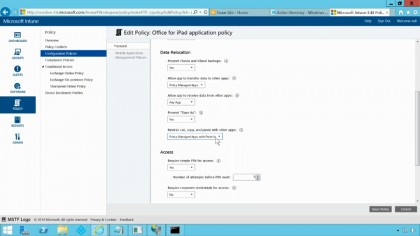Microsoft's hybrid future for businesses: cloud now, system updates later
TechEd Europe saw the cloud being put firmly first
Early next year the Intune service will get the promised Office for iPad management features that let you stop users moving data from Excel, Word, PowerPoint, Outlook or OneDrive for Business into iOS apps unless they're apps you're also managing through Intune. Microsoft will have managed viewers for PDF and multimedia files, but you'll also be able to manage your own mobile apps through Intune.
"If you have an iOS app or an Android app we'll have a tool so you can go wrap that application and bring it within the managed ecosystem on the device," senior director for enterprise mobility Alex Conway told us. "Then you can use Intune to set policy around what you want to restrict. We have the basic abilities: where you can save a file and whether you can cut, copy and paste – but we expect to have more options in time."
Intune will also let you lock down devices. "Using supervisor mode, you can set policy to turn an iPad into a kiosk with just one app on it; you can't even rotate the device or change the volume if you want to set it that way," Conway said.
Azure introductions
Another new Azure service lets you set up single sign-on for your own web apps running on your own server by making them available through the Azure Active Directory Proxy (Azure AD already gives you single sign-on for cloud services like Box and Twitter). To make that easier to set up, there's a new Azure AD Connect wizard that links your Active Directory system to Azure.

The Internet of Things is another place the cloud makes sense, and Microsoft expects businesses to be using IoT devices sooner rather than later, and analysing the information from those devices in Azure with new services announced at TechEd: Event Hubs (for collecting data from sensors) and Stream Analytics (for processing that data).
It's not just London Underground putting sensors on every train, elevator and escalator to help predict when they'll need maintenance or Coca Cola tracking when Freestyle drinks kiosks need refilling – shops can use a sensor like Kinect to find out how much time people spend looking at different product displays to see if they're able to find what they're looking for. You might pull that data into Excel PowerView or PowerMaps to analyse it, then send the information to a mobile app for shop assistants to use.
Increasingly, the way businesses use technology is a mix of PCs, mobile devices, their own servers and cloud services. Microsoft is trying to come up with systems businesses will use all of those ways, plus enabling firms to manage the different devices and services they're using. That's why this year's TechEd was such a hybrid mix.
Sign up to the TechRadar Pro newsletter to get all the top news, opinion, features and guidance your business needs to succeed!
Mary (Twitter, Google+, website) started her career at Future Publishing, saw the AOL meltdown first hand the first time around when she ran the AOL UK computing channel, and she's been a freelance tech writer for over a decade. She's used every version of Windows and Office released, and every smartphone too, but she's still looking for the perfect tablet. Yes, she really does have USB earrings.